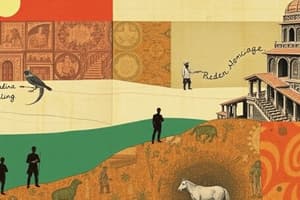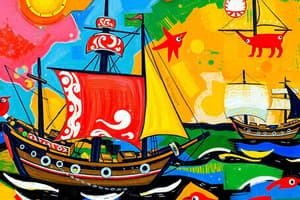Podcast
Questions and Answers
Which trade route was primarily responsible for the exchange of spices like cinnamon and nutmeg between Europe and Asia?
Which trade route was primarily responsible for the exchange of spices like cinnamon and nutmeg between Europe and Asia?
- Venetian Trade
- Arabian Trade
- Maritime Routes
- Silk Road (correct)
Which method was NOT commonly used alongside spices for food preservation during the Middle Ages?
Which method was NOT commonly used alongside spices for food preservation during the Middle Ages?
- Drying
- Refrigeration (correct)
- Salting
- Pickling
How did Arab merchants contribute to the spice trade in the Middle Ages?
How did Arab merchants contribute to the spice trade in the Middle Ages?
- By acting as intermediaries between East and West (correct)
- By producing the spices themselves
- By controlling spice prices in Europe
- By transporting spices primarily by land
What was a significant economic impact of the high demand for spices during the Middle Ages?
What was a significant economic impact of the high demand for spices during the Middle Ages?
Which of the following spices was particularly associated with the Spice Islands in modern-day Indonesia?
Which of the following spices was particularly associated with the Spice Islands in modern-day Indonesia?
Flashcards are hidden until you start studying
Study Notes
Spices in the Middle Ages
Trade Routes
- Silk Road: Key trade route linking Europe and Asia; facilitated the exchange of spices like cinnamon and nutmeg.
- Maritime Routes: Sea routes around Africa and through the Indian Ocean; important for transporting spices from India and Southeast Asia.
- Arabian Trade: Arab merchants played a crucial role in spice trade, acting as intermediaries between East and West.
- Venetian Trade: Venice became a major hub for spice trade in Europe, controlling supply and prices.
- Spice Islands: Modern-day Indonesia known for producing cloves, nutmeg, and mace; highly sought after in Europe.
- Economic Impact: High demand for spices led to significant wealth accumulation and financing of expeditions.
Preservation of Food
- Role of Spices: Spices were essential for preserving food, enhancing flavor, and masking spoilage.
- Salting and Drying: Common techniques used alongside spices to prolong the shelf-life of meats and fish.
- Pickling: Use of vinegar and spices for preserving vegetables; provided essential nutrients during winter months.
- Medicinal Properties: Many spices (e.g., garlic, ginger) were valued not only for flavor but also for their health benefits.
- Culinary Practices: Spices became integral to cooking, leading to the development of distinct regional cuisines.
- Cultural Exchange: Spices influenced culinary traditions across different cultures, promoting diversity in food preferences.
Trade Routes
- The Silk Road was a vital connection between Europe and Asia, facilitating the exchange of high-valued spices such as cinnamon and nutmeg.
- Maritime routes around Africa and through the Indian Ocean were essential for transporting spices from regions such as India and Southeast Asia.
- Arab merchants served as key intermediaries in the spice trade, effectively connecting Eastern spice producers with Western markets.
- Venice emerged as a major trading hub in Europe, controlling the spice supply and significantly influencing prices.
- The Spice Islands, located in modern-day Indonesia, were renowned for their production of cloves, nutmeg, and mace, which were highly desired in European markets.
- The increasing demand for spices contributed to significant wealth accumulation and financed exploratory expeditions during this era.
Preservation of Food
- Spices played an essential role in food preservation, flavor enhancement, and odor masking to counter spoilage.
- Common preservation techniques included salting and drying, which were often used in combination with spices to extend the shelf-life of meat and fish products.
- Pickling involved the use of vinegar and spices to preserve vegetables, ensuring a supply of essential nutrients during the winter months.
- Several spices, such as garlic and ginger, were also valued for their medicinal properties, contributing to overall health.
- The integration of spices into culinary practices led to the emergence of distinct regional cuisines across different cultures.
- Spices fostered cultural exchange by influencing culinary traditions and promoting diversity in food preferences globally.
Studying That Suits You
Use AI to generate personalized quizzes and flashcards to suit your learning preferences.




